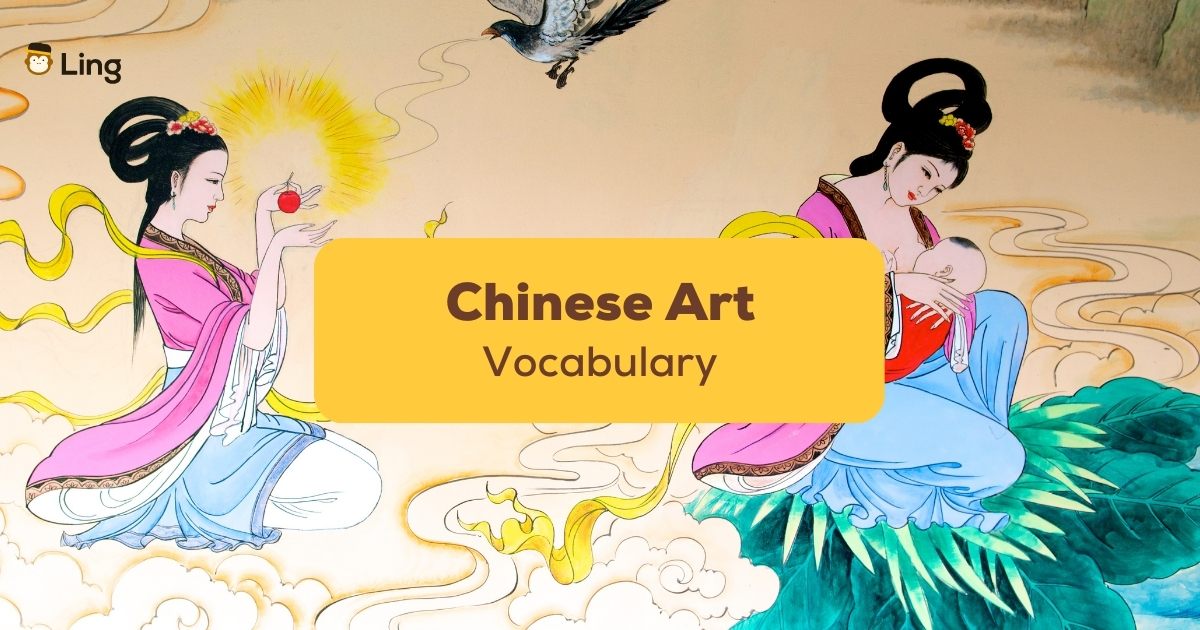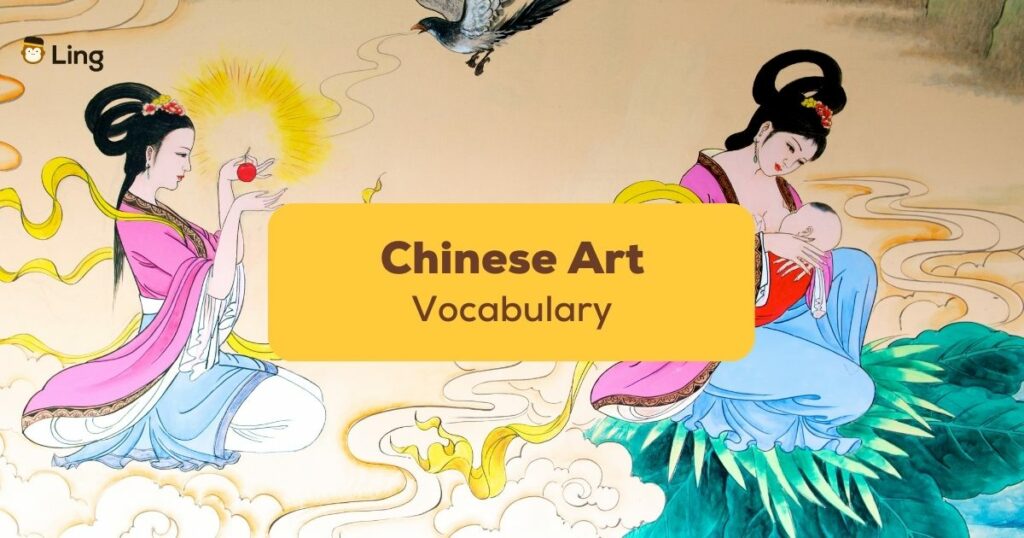Hey there, fellow art enthusiasts! If you’ve been wanting to dive into the fascinating world of Chinese art, you’re in the right place. We’ve put together 20 essential Chinese art vocabulary words that every art lover should know.
With these words in your arsenal, you can better appreciate and discuss Chinese art’s rich and diverse history. Let’s get started on this artistic adventure, shall we?
Chinese Art Vocabulary For Traditional Art Forms
First, let’s look at some vocabulary words that are important for understanding traditional Chinese art. This first set of words is essential for understanding Chinese culture and traditional art. You’ll need to know these words to get into the nitty-gritty of traditional Chinese paintings, calligraphy, or sculpture. Be sure to check out our post on modern art vocabulary as well!
Calligraphy – 书法 (Shūfǎ)
Calligraphy, or shūfǎ, is the beautiful and intricate art of writing Chinese characters with a brush and ink. This art has been alive since the Ming and Qing dynasties. It’s not just about writing words but also about expressing the artist’s emotions and creativity. Think of it as a mesmerizing dance of the brush on paper!
Painting – 绘画 (Huìhuà)
Huìhuà is the Chinese term for painting, and it covers a wide range of styles and techniques. Traditional Chinese paintings often feature stunning landscapes, delicate flowers, and majestic animals. So, next time you admire a gorgeous Chinese painting, you can show off your knowledge by calling it huìhuà!
Pottery And Porcelain – 陶瓷 (Táocí)
Táocí refers to the fascinating world of Chinese pottery and porcelain. From simple clay pots to intricately designed vases, Chinese ceramics have been admired for their beauty and craftsmanship for centuries. If you’re a fan of delicate painted tea sets and elegant porcelain figurines, you’ll definitely want to remember the word táocí!
Sculpture – 雕塑 (Diāosù)
Last, we have diāosù, the Chinese term for sculpture. Chinese sculptures come in all different types, shapes, and sizes, from tiny jade carvings to massive stone statues. Whether you’re marveling at a fierce terracotta warrior or a graceful bronze Buddha, you’ll be able to appreciate Chinese history even more by knowing the word diāosù.

Chinese Art Vocabulary For Techniques And Styles
Next, we’ll explore some essential Chinese art vocabulary words related to various techniques and styles. With this knowledge, you’ll be able to appreciate and discuss Chinese art like a pro.
Brushwork – 笔法 (Bǐfǎ)
Bǐfǎ refers to the unique way an artist uses their brush to create different textures and effects on paper or silk. It’s like the artist’s signature style. So, when you’re admiring Chinese art, pay attention to the brushwork – it’s where the magic happens!
Ink and Wash Painting – 水墨画 (Shuǐmòhuà)
Shuǐmòhuà is a traditional Chinese art form that uses ink and water to paint and create stunning, monochromatic masterpieces. This style is about capturing a subject’s essence with minimal strokes and a perfect balance of light and dark. It’s like poetry on paper, and it’s absolutely mesmerizing to look at.
Chinese Landscape Painting – 山水画 (Shānshuǐhuà)
Shānshuǐhuà is a popular genre in Chinese art that captures the beauty of nature. This art form uses intricate and detailed depictions of nature, like the famous Yellow Mountain. This style is about representing the physical world. It’s also about evoking our emotions and spiritual connections with nature. So, when you’re gazing at a Chinese landscape painting, take a moment to feel the energy and harmony it conveys.
Figure Painting – 人物画 (Rénwùhuà)
Rénwùhuà is a Chinese art style that focuses on portraying people in various settings and situations. This genre is all about capturing the essence of a person, their emotions, and their place in the world. From emperors and scholars to everyday folks, figure paintings let us take a peek into the lives of Chinese people from different eras and class backgrounds.

Chinese Art Vocabulary For Materials & Tools
As you dive deeper into Chinese art, knowing the materials and tools that make these masterpieces possible is essential. Here’s a list of must-know vocabulary words related to the tools and materials used in creating Chinese art.
- Paper – 纸 (zhǐ)
- Ink – 墨 (mò)
- Silk – 丝绸 (sīchóu)
- Colors – 颜料 (yánliào)
- Brush – 毛笔 (máobǐ)
- Inkstone – 砚台 (yàntái)
- Inkstick – 墨条 (mòtiáo)
- Seal – 印章 (yìnzhāng)
- Palette – 调色板 (tiáosèbǎn)
Chinese Vocabulary For Other Art Forms
Besides traditional painting and calligraphy, Chinese art boasts a wide variety of other art forms deeply rooted in history and culture. Ancient China has a rich cultural history, and contemporary art continues to thrive in the country in various forms. From the mesmerizing Peking Opera to intricate paper cutting, there’s so much to explore and appreciate.
Here’s a list of other Chinese art forms and their English, Chinese, and Pinyin translations.
- Peking Opera – 京剧 (Jīngjù)
- Shadow Puppetry – 皮影戏 (Píyǐngxì)
- Paper Cutting – 剪纸 (Jiǎnzhǐ)
- Clay Figurines – 泥人 (Nírén)
- Dough Sculpting – 捏面人 (Niēmiànrén)
- Chinese Knotting – 中国结 (Zhōngguó jié)
- Embroidery – 刺绣 (Cìxiù)
- Cloisonné – 景泰蓝 (Jǐngtàilán)
- Lacquerware – 漆器 (Qīqì)
- Chinese Seal Carving – 篆刻 (Zhuànkè)
Master the Language and Immerse Yourself In Chinese Art
If you’re an art lover passionate about Chinese art, why not take your interest to the next level by learning the Chinese language? Whether you’re planning to study at the China Academy of Art or the Central Academy of Fine Arts, having a solid foundation in the language can significantly enhance your experience and deepen your understanding of Chinese art.
Learning Chinese will help you communicate with fellow artists and instructors. It will also allow you to appreciate the nuances and importance of Chinese culture and history, which are deeply intertwined with the country’s art forms. As you delve into the language, you’ll find yourself better equipped to explore and interpret the rich layers of meaning in Chinese art.
Learn Chinese With Ling
Are you looking for a fun, engaging, and effective way to learn Chinese? Look no further! Introducing the Ling app, your new best friend on mastering the Chinese language. Ling app offers a unique learning experience that combines practical lessons and interactive exercises, making it a perfect choice for learners of all levels.
Ready to embark on an exciting journey of learning Chinese? Ling is here to support and guide you every step of the way. With Ling’s comprehensive and engaging approach, you’ll speak Chinese confidently in no time. So, what are you waiting for?
Download the app on App Store or Play Store today!


































































